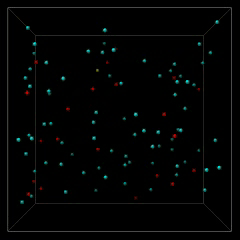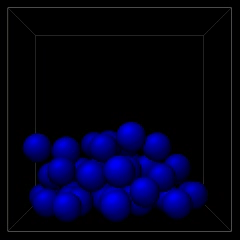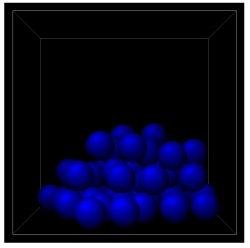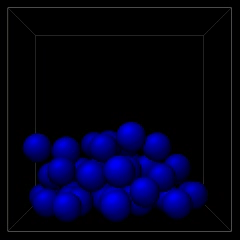Join us for conversations that inspire, recognize, and encourage innovation and best practices in the education profession.
Available on Apple Podcasts, Spotify, Google Podcasts, and more.
In Session 2, we introduced the particle model of matter by looking at examples of the behavior of matter on a macroscopic level that were best explained by assuming matter was made of particles. In these “Virtual Particle Labs,” you will manipulate a realistic scientific model of matter as particles in order to build your understandings about how interactions and changes on a microscopic scale relate to the macroscopic scale.
Each time we show a simulation or give you a choice to change something about a simulation, we’ll ask you to predict the result, so you can check your understandings of the macroscopic implications of the microscopic model.
Each Virtual Particle Lab has the following parts:
In Session 2, one of the macroscopic behaviors of matter that we looked at as a reason for preferring the particle model to the continuous model was the compressibility of gases. In the Science Studio, we saw that Joana could push the plunger of a closed, air-filled syringe, which indicated that its volume was not constant. Similarly, we saw that David could not do the same with a water-filled syringe, which indicated that its volume is constant. In this lab, you’ll experiment with a realistic model of air and water to better connect the particle model to your intuitive understanding of the real world.
Below, we show a simulation of air, where the size of the air molecules has been increased and time has been slowed down.
In order to make the particles visible, we illustrate a very small volume — the side of the box is 161 x 10-10 m (or 161 angstroms, 1 angstrom = 10-10 m). For a sense of scale, each side of the box is 1/1000 the diameter of a human hair. At the scale of the simulation, each atom is approximately the correct size, shown as 3 x 10-10 m or 3 angstroms in diameter. This simulation is set up to show what air (a gas) at room temperature would look like.
A particle in this simulation is represented as a small sphere: blue for nitrogen (78% of the particles in air), red for oxygen (21% of the particles in air) and yellow for argon (about 1% of the particles in air). When you start the simulation by clicking “run,” you’ll see an animation in which each increment is 10-14 seconds — the real particles in air move much faster.
One of the most important ideas of the particle model is that particles are in motion. When you run the simulation, which of the following do you think will be true?
A. The particles will move in all directions, but they will stay in about the same position.
B. The particles will move in all directions, but they will eventually float to the bottom of the container.
C. The particles will move in all directions, and they will continue to move across the entire container.
D. The particles will move up and down only, because of gravity.
C. The particles will move in all directions, and they will continue to move across the entire container.
Particles in a gas move in all directions and continue to move across the entire container. Characteristics of this motion are related to the temperature of the particles. As long as the temperature remains constant, the motion of particles will not slow down.

Now we are going to apply a force to the top of the box, compressing it in the same way that Joana pressed the plunger to compress the air in the syringe. You can choose to push with no force, or with one, two, four or eight units of force. The final volume in each case will be shown as a fraction of the original volume. With each compression, the distance between particles will, on average, be smaller.
Doubling the force on a gas results in which of the following?
A. Doubling the force on the gas will reduce its volume by half.
B. Doubling the force on the gas will reduce its volume by less than half.
C. Doubling the force on the gas will reduce its volume by more than half.
D. There will be no significant change.
Interactive disabled
B. The particles are squeezed together by the force applied by the piston, and the spaces between them get smaller. Doubling the force, however, does not result in halving the volume, because as we squeeze the particles closer together, the repulsive forces between them get stronger and, as a result, we need to push with even greater force to make the volume decrease more. It is for this reason that Joana could not push the plunger of the air-filled syringe beyond a certain point.
Now we’ll take a look at a simulation of a liquid. We’ve made the box smaller by a factor of eight, but the particles are still the same size as those in the previous section. (This is why they look bigger.) You can think of this as a simulation of water.
When you see the simulation, which of the following do you think will be true?
A. The particles will move in all directions, but they will stay in about the same position.
B. The particles will move in all directions, but they will eventually float to the bottom of the container.
C. The particles will move in all directions, and they will continue to move across the entire container.
D. The particles will move up and down only, because of gravity.
A. The particles will move in all directions, but they will stay in about the same position.
The behavior of particles in this situation seems to be very different from those in a gas. Here, there are no particles hitting the walls, and they seem to move quickly, but do not move very far from their original position. Given this observation, let’s ask another repeat question…

In the case of water, what kinds of forces are acting between the particles?
A. Attractive
B. Repulsive
C. Both
In the case of water, what kinds of forces are acting between the particles?
C. Both
Although the motion seems different from a gas, the same kinds of forces act in a liquid. Attractive forces hold the particles much closer together because they are moving more slowly. However, the particles do not completely clump together, so there must be replusive forces between the particles when they get too close together. (Replay the simulation to watch the particles bump off of one another).
Now we are going to apply a force to the top of the box as if we were pushing a piston down on the liquid. This is equivalent to David squeezing the water-filled syringe in the program. You can choose to push with no force, or with one, two, four or eight units of force. The final volume in each case will be shown as a fraction of the initial volume.
Doubling the force on a liquid results in which of the following?
A. Doubling the force on the liquid will reduce its volume by half.
B. Doubling the force on the liquid will reduce its volume by less than half.
C. Doubling the force on the liquid will reduce its volume by more than half.
D. There will be no significant change.
D. Although the spaces between the particles in a liquid may get slightly smaller, the particles are already “touching” each other. This means that the distance between particles is small enough that the repulsive forces between particles have gotten so strong that typical forces cannot cause them to be squeezed together any more. However, the particles are moving slowly enough so that the attractive forces can still hold them together.’
The forces between any two particles are tiny, but because so many particles make up a macroscopic object (like syringe of water), we cannot overcome their combined force (as David could not compress the water in the syringe).
In this lab, we’ve seen that the space between particles is a result of the battle between particles’ intrinsic motion and the attractive and repulsive forces between them.
Particles in a liquid or solid phase are moving slowly enough so that the attractive forces are able to hold particles next to each other. If the particles are compressed any more, however, (like David squeezing the plunger of the water-filled syringe), the shorter distances between them cause the repulsive forces to take over. When this happens, there is no change in volume on a macroscopic scale.
Particles in a gas phase are moving too rapidly for the attractive forces to hold them together. An outside force (like Joana pushing on the plunger of the air-filled syringe) will squeeze them closer together, but when they get close enough the repulsive forces take over and the gas becomes harder to compress.